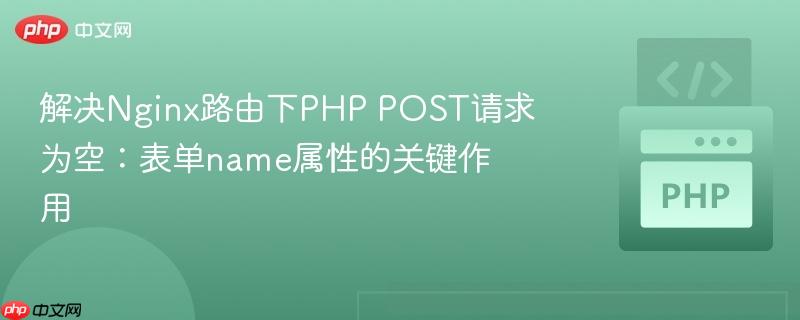
在开发web应用时,我们经常会遇到这样的情况:前端表单通过post方法提交数据,nginx服务器将所有请求正确地路由到index.php,但当php脚本尝试访问$_post全局变量时,它却始终为空。这常常令人困惑,因为nginx的配置看起来是正确的。
典型的Nginx路由配置如下:
location / {
try_files $uri $uri/ /index.php;
}此配置的目的是将所有非文件或非目录的请求重写到index.php,由PHP应用内部的路由逻辑处理。例如,当一个POST请求发送到/login-post时,Nginx会将其转发给index.php,PHP脚本中的$_SERVER['REQUEST_URI']会是/login-post。
PHP处理逻辑示例:
<?php
// index.php
$request = $_SERVER['REQUEST_URI'];
switch ($request) {
case '/' :
// 处理首页请求
break;
case '/login' :
// 处理登录页面请求
break;
case '/login-post':
// 预期接收POST数据,但$_POST为空
print_r($_POST); // 此时输出 Array()
break;
default:
http_response_code(404);
echo "404 Not Found";
break;
}
?>导致$_POST数组为空的最常见且容易被忽视的原因,是HTML表单中的输入元素(如、
立即学习“PHP免费学习笔记(深入)”;
当浏览器提交表单时,它会收集所有具有name属性的输入元素的值,并将这些值作为键值对发送到服务器。name属性的值将成为POST数据中的键,而输入元素的值则成为对应的值。如果一个输入元素没有name属性,它的值就不会被包含在提交的表单数据中。
考虑以下原始的HTML表单:
<form class="form-signin text-center" action="/login-post" enctype="multipart/form-data" method="post" style="max-width: 400px">
<h1 class="h3 mb-3 font-weight-normal">Please sign in</h1>
<input type="email" id="inputEmail" class="form-control" placeholder="Email address" required autofocus>
<input type="password" id="inputPassword" class="form-control" placeholder="Password" required>
<div style="width: 100%; display: flex; align-content: end; flex-direction: row-reverse;">
<button class="btn btn-lg btn-primary btn-block" style="width: 100px" type="submit">Sign in</button>
</div>
<p class="mt-5 mb-3 text-muted">© 2017-2018</p>
</form>在这个表单中,ail"> 和 word"> 元素都只定义了 id 属性,而没有 name 属性。这就是导致PHP $_POST 为空的关键原因。
要解决此问题,只需为所有需要提交数据的表单输入元素添加唯一的name属性。
修正后的HTML表单示例:
<form class="form-signin text-center" action="/login-post" enctype="multipart/form-data" method="post" style="max-width: 400px">
<h1 class="h3 mb-3 font-weight-normal">Please sign in</h1>
<input type="email" id="inputEmail" name="email" class="form-control" placeholder="Email address" required autofocus>
<input type="password" id="inputPassword" name="password" class="form-control" placeholder="Password" required>
<div style="width: 100%; display: flex; align-content: end; flex-direction: row-reverse;">
<button class="btn btn-lg btn-primary btn-block" style="width: 100px" type="submit">Sign in</button>
</div>
<p class="mt-5 mb-3 text-muted">© 2017-2018</p>
</form>现在,当用户提交此表单时,浏览器会将 email 和 password 作为键,并将用户输入的值作为对应的值,一同发送到服务器。
PHP脚本现在可以正确地访问这些数据:
<?php
// index.php
$request = $_SERVER['REQUEST_URI'];
switch ($request) {
// ... 其他case ...
case '/login-post':
print_r($_POST); // 现在会输出类似 Array ( [email] => user@example.com [password] => mypassword )
// 可以在这里处理登录逻辑,例如:
$email = $_POST['email'] ?? '';
$password = $_POST['password'] ?? '';
// ...
break;
// ...
}
?>通过理解name属性在HTML表单提交中的核心作用,并遵循正确的表单构建实践,可以有效避免PHP $_POST为空的问题,确保Web应用的正常数据交互。
以上就是解决Nginx路由下PHP POST请求为空:表单name属性的关键作用的详细内容,更多请关注php中文网其它相关文章!

Copyright 2014-2025 https://www.php.cn/ All Rights Reserved | php.cn | 湘ICP备2023035733号